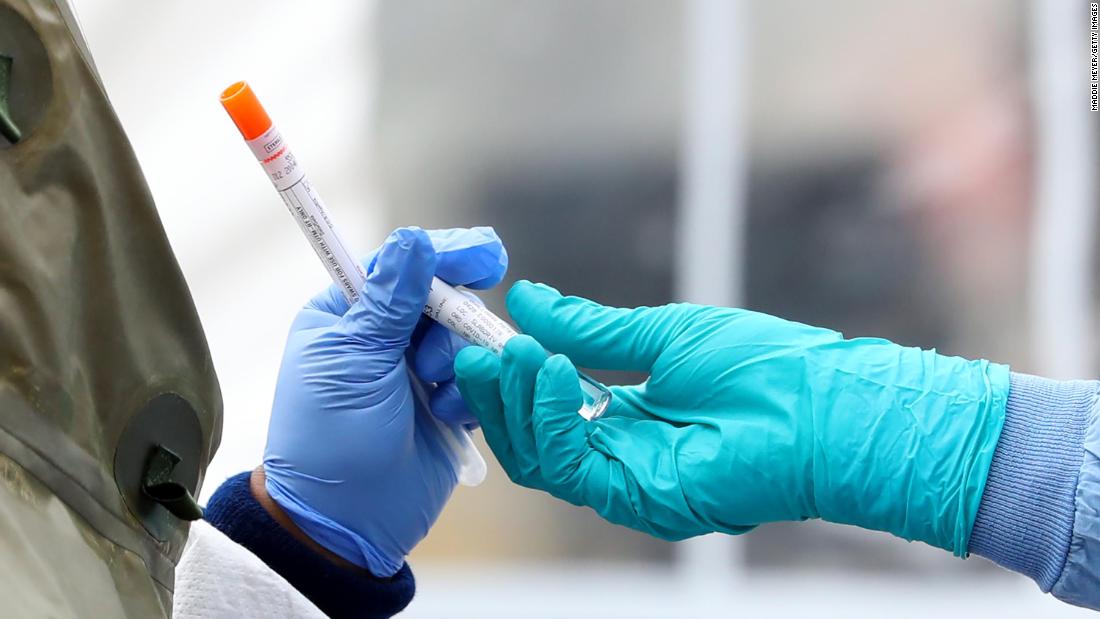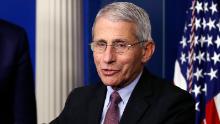[ad_1]
What’s more, the biggest commercial labs say they have sufficient supplies. In fact, the federal government laid out plans to give them a leg up.
A White House Coronavirus Task Force document shared with governors last week and obtained by CNN states the federal government plans to prioritize supplies for big commercial labs — which have provided more than half of the nation’s testing.
The supply crunch is the latest problem plaguing efforts to expand testing capacity around the US. Public health experts say the country needs to vastly step up its testing in order to safely restart the economy and let Americans go back about their daily lives — calling for even more than the White House goal to test at least 2% of every state’s population every month.
Doctors have had to prioritize testing the sickest patients because of a dearth of supplies, said Susan Butler-Wu, an associate professor of clinical pathology at the University of Southern California and a clinical microbiology lab director in Los Angeles. Her lab recently put in an order for 1,000 medical swabs and ended up receiving just 100 — enough to do about two days of tests, she said. Other orders have been canceled outright.
“Literally, every day, we’re counting our swabs and craving for more,” Butler-Wu said.
It’s a similar story elsewhere around the country. In Washington, DC, the district’s labs are running at about half of testing capacity due to shortages of reagents, officials said. And the Hackensack Meridian Health network in New Jersey is doing only 500 tests a day even though it has the lab capacity to do seven times that, according to its chief physician executive, Dr. Daniel Varga.
At the same time, three of the country’s largest commercial labs — Quest Diagnostics, LabCorp and BioReference Laboratories — told CNN they have sufficient supplies overall, with an association that represents them saying they were ready to conduct more tests.
Documents obtained by CNN through a public records request suggest that the federal government plans to prioritize the distribution of supplies to large commercial labs, even as hospitals say they’re starved for supplies.
According to a plan the administration’s coronavirus task force shared with Colorado last week, after states identify regional labs that require more capacity, the task force “will partner with commercial manufacturers of testing equipment to ensure those regional labs, along with large commercial labs, are prioritized for receiving lab testing supplies.”
Butler-Wu said that if the government and manufacturers are prioritizing commercial and regional labs at the expense of smaller hospital labs that would be “deeply troubling” and “contrary to all the principles of optimal patient care.” She said hospitals can get tests back for their patients far faster from their in-house labs than by sending samples to the big corporate labs. And an early test result can help get patients the potentially life-saving therapies they need sooner, she added. LabCorp and Quest say their average turnaround time for test results is one to two days.
The Department of Health and Human Services did not directly respond to a request for comment about that criticism, but a spokesperson said that an interagency team “is working together with States, laboratory directors and manufacturers to address issues that have been raised from technical support, to insufficient laboratory personnel, to funding, to supplies such as swabs, transport media, tubes, extraction reagents and test kits.”
Some medical leaders are ringing the alarm and begging federal officials to step in to redistribute supplies and to better coordinate what is now largely a free-for-all.
Trump blueprint puts responsibility on states
The US has greatly expanded coronavirus testing capacity over the last month and a half, crossing the milestone of more than 5 million tests, according to the President. The situation has improved markedly from the early days of the pandemic, when patients faced Kafkaesque struggles to get tested and some results lagged behind a week or more.
But that growth in testing has also resulted in a spike in demand for supplies that has overwhelmed supply chains, with public, private and academic labs competing over scarce testing components. Complicating matters, major suppliers of key equipment have been shaken by the pandemic: One of the largest producers of medical-grade swabs, for example, is based in Lombardy, Italy, a Covid-19 hot spot.
In a new strategy that Trump released on Monday, states would take on the brunt of the responsibility for ramping-up testing. State governments should “develop testing plans and rapid response programs” and “maximize the use of all available testing platforms and venues,” according to a blueprint released by the administration. They would also “identify and overcome barriers to efficient testing,” including “misallocation of supplies” and “logistical failures.”
The federal government would provide strategic direction and act as the “supplier of last resort” for the tests, the blueprint says.
So far, the major commercial labs are some of the few in the country that say they have enough testing supplies.
Quest Diagnostics said it had been able to tap into its global supply chain and find alternate manufacturers for swabs, transport chemicals and protective gear. A spokesperson said the company hadn’t requested or received help from the federal government in securing supplies.
And LabCorp is “not currently experiencing shortages of supplies to perform tests,” a spokesperson said. “We are working continually to make sure that collection supplies are in the locations where they are in greatest demand and provided to clients in appropriate quantities.”
One of the largest companies that produce chemical reagents, Roche, said that after consulting with the federal government it had initially prioritized the large commercial labs “with the necessary instruments in place and the ability to quickly collect, process and move samples to maximize testing capabilities and provide the widest geographic coverage,” a spokesperson said.
While Roche is expanding its testing capacity and increasing the number of hospitals receiving its tests, demand continues to outpace supply, the spokesperson said.
Experts said there are legitimate reasons to prioritize the large commercial labs. Meg Wyatt, a senior director of diagnostics supply-chain services for Premier Inc., a company that provides services for about 4,000 hospitals and health systems, said it was most efficient for manufacturers to send supplies to the test providers that perform the most tests, though she said she did not believe commercial labs should do all testing.
Heather Pierce, the senior director for science policy and regulatory counsel at the Association of American Medical Colleges, agreed that it made sense for supplies to be prioritized for commercial labs in some cases, but added that “it’s in no one’s interest to have an academic lab be wasting hours or days phoning and emailing a (supplier) if those reagents are never going to come.”
Labs begging for help
Three major groups representing labs — the Association of American Medical Colleges, the Association of Public Health Laboratories and the American Association for Clinical Chemistry — have warned that supply shortages are growing critical.
Nearly every academic lab that’s testing for Covid-19 has run into some supply shortages in recent weeks that have slowed their ability to test, Pierce said.
“What we’re seeing and what we’ve been hearing now for weeks is that each lab is really functioning on its own,” Pierce said. “So one lab may have a shortage of swabs, another one might have a shortage in one type of reagent and still another in a different type of reagent.”
“If any one of those components is in short supply, then nothing along the chain can happen,” she said.
Some labs have unintentionally been bidding against one another as they rush to secure supplies, she said.
“The problem we have is the volume of tests that are needed is extraordinary,” Pierce said. “We’re not talking about tens of thousands or hundreds of thousands, but millions of tests. And so any little hiccup in the supply chain can really bring the maximum testing capacity down.”
Kelly Wroblewski, the Association of Public Health Laboratories director of infectious disease, said earlier this month that some public health labs have only two days’ worth of the swabs or other supplies needed to continue testing.
“In many parts of the country we’re still not in a place to meet the demand — particularly if that demand expands significantly,” Wroblewski said.
And the task force said it had created a “full inventory of all (testing) platforms that exist in each State, down to the zip code level,” which could help local officials organize their testing supply resources going forward.
Patchwork of shortages
Shortages have led to a bizarre patchwork of supply availability between states and even in different regions of the same state.
Some community health centers in the Detroit area have enough testing supplies like swabs but lack face shields and gowns, limiting the capacity there, said Jen Anderson, a spokeswoman for the Michigan Primary Care Association, which represents community health centers around the state. But in other parts of the state, the problem is with a shortage of swabs — health centers have had to slow down their testing in order not to run out, she said.
“We’ve been dealing with an inconsistent spread of supplies and PPE throughout the state,” Anderson said. “It definitely slows things down.”
Dr. Kimberly Farrow, the interim president and CEO of Central City Integrated Health, a health care center in Detroit, told CNN her organization could test more patients if it had more protective equipment.
“Because we don’t have the equipment, we’re not only not able to test for Covid but also not able to see patients for basic care needs,” Farrow said.
In Ohio, Mary Boosalis, the president and CEO of the Dayton-based Premier Health hospital system, wrote in an April 18 letter to Gov. Mike DeWine that hospital labs are facing an “inequitable distribution of reagents.” While other regions of the state were allocated enough reagents to do about 1,000 tests, Premier had the resources to conduct only 147 daily tests, Boosalis wrote — leaving patients in the Dayton area “disadvantaged and denied expedited testing when it exists elsewhere in Ohio.”
Reagent suppliers told the hospital system that they couldn’t sell it more of the chemicals because state and federal officials had directed them to hospitals and labs in other parts of the state, Boosalis said.
The Ohio Department of Health said the state government hasn’t prevented labs from getting supplies and has been working to get reagent companies to send more materials to the state.
Public health officials in four states and Washington, DC, told CNN that labs in their jurisdictions are experiencing supply shortages.
In DC, labs have enough capacity to process about 3,700 tests per day, Dr. LaQuandra Nesbitt, the director of the DC Department of Health, told reporters Monday. But because of shortages in reagents, officials are able to do only less than half that, about 1,500 per day, she said. That number could drop even farther if shortages in sampling kit supplies and protective equipment get worse, she added.
For now, labs are hanging on to the supplies they can get and hoping for some relief, said Butler-Wu, of USC. “Essentially,” she said, “every day is a struggle.”
CNN’s Drew Griffin, Majlie de Puy Kamp and Nelli Black contributed to this report.






















